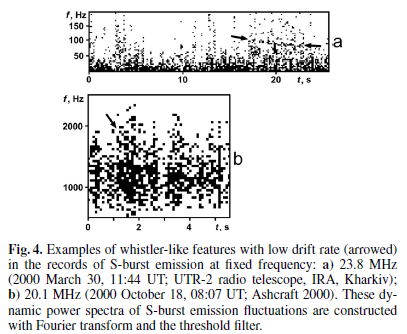I review Arkhypov, O. V. and Rucker, H. O. 2007, "Effects of magnetohydrodynamic waves in Jovian decametric emission"
http://adsabs.harvard.edu/abs/2007A%26A...474.1031A
Abstract: "The flux variability of Jovian decametric radio emission (DAM) is analyzed to search for its possible modulations by magnetohydrodynamic waves of ultra-low frequencies (ULF). The ULF modulating waves are found in DAM dynamic spectra as a moving pattern (moire) on the background of Jovian millisecond radio bursts (S-bursts). Their frequency drift ( 55 MHz/s) corresponds to the wave motion to Jupiter with Alfvén velocity ( 4 × 104 km s-1). There are whistler-like drifting details in the dynamic power spectra of ULF variations of S-burst emission flux at fixed radio frequency. Their frequency drift rates are consistent with whistlers that are dispersed mainly in the Io torus. Formally our analysis of DAM reveals the specific 2s-modulation of S-burst emission corresponding to the known magnetic pulsations near gyrofrequencies of heaviest ions (SO{2}+ and SO+) in the Io torus."
Monday, February 17, 2014
Sun 140216, 12 selected spectra and charts, types I II III IV V
Many thanks to the Taxpayers of France, the Nancay Decametric Array Team at the Nancay Radio Astronomy Station of Paris Observatory, Trinity College Dublin Astrophysics Group, NOAA SWPC, and NASA SDO HMI Magnetograph Team.
Friday, February 14, 2014
Arkhypov and Rucker 2014, "Dispersion-like phenomena in Jovian decametric S-bursts: Tabooed Facts"
I review Arkhypov and Rucker 2014, "Dispersion-like phenomena in Jovian decametric S-bursts: Tabooed Facts"
http://adsabs.harvard.edu/cgi-bin/bib_query?arXiv:1402.1966
Abstract: "The dominant viewpoint on Jovian decametric S-burst emission neglects the time delay of the radiation, although its base theory of electron cyclotron maser instability allows a significant decreasing of X-mode group velocity near the cutoff frequency at the bottom of source region. We searched for effects of the frequency-related delay of radiation in broadband Jovian radio storms consisting of periodic S-bursts (S-burst trains) at 16 to 30 MHz. It was found that up to 1% of bursts in a train are of distorted meandering shape in dynamic spectrum, where the emission from one radio source was observed at several frequencies simultaneously. It is difficult to explain such spectra in terms of radio waves beaming or causality without significant frequency-related delay of radio emission. We found experimentally that the frequency drift rate of middle lines of such events coincides with the drift rate of disturbances in common S-bursts. This indicates a general distortion of the dynamic spectrum of S-bursts. As a result, the correlation method for the measurement of the spectral distortion is proposed. Using this method, we found the approximation coefficients for the distortion in 32 spectra of 8 Io-B storms. The corrected spectra formally show that S-burst trains do not move mainly outward from Jupiter, as it is usually assumed, but fly in the opposite direction. Our simulation confirms that the dispersion is capable in principle to reproduce the found spectral distortion. Hence, the dispersion-like phenomena in Jovian S-bursts deserve discussion because they have no satisfactory explanations in terms of traditional approach."
http://adsabs.harvard.edu/cgi-bin/bib_query?arXiv:1402.1966
Abstract: "The dominant viewpoint on Jovian decametric S-burst emission neglects the time delay of the radiation, although its base theory of electron cyclotron maser instability allows a significant decreasing of X-mode group velocity near the cutoff frequency at the bottom of source region. We searched for effects of the frequency-related delay of radiation in broadband Jovian radio storms consisting of periodic S-bursts (S-burst trains) at 16 to 30 MHz. It was found that up to 1% of bursts in a train are of distorted meandering shape in dynamic spectrum, where the emission from one radio source was observed at several frequencies simultaneously. It is difficult to explain such spectra in terms of radio waves beaming or causality without significant frequency-related delay of radio emission. We found experimentally that the frequency drift rate of middle lines of such events coincides with the drift rate of disturbances in common S-bursts. This indicates a general distortion of the dynamic spectrum of S-bursts. As a result, the correlation method for the measurement of the spectral distortion is proposed. Using this method, we found the approximation coefficients for the distortion in 32 spectra of 8 Io-B storms. The corrected spectra formally show that S-burst trains do not move mainly outward from Jupiter, as it is usually assumed, but fly in the opposite direction. Our simulation confirms that the dispersion is capable in principle to reproduce the found spectral distortion. Hence, the dispersion-like phenomena in Jovian S-bursts deserve discussion because they have no satisfactory explanations in terms of traditional approach."
Labels:
Io-B,
Jovian,
Jovian radiation models,
References to Papers,
type S
Sun 140214, 7 selected events
Many thanks to the Taxpayers of France, the Nancay Decametric Array Team at the Nancay Radio Astronomy Station of Paris Observatory, Trinity College Dublin Astrophysics Group, NOAA SWPC, and NASA SDO HMI Magnetograph Team.
Subscribe to:
Posts (Atom)




























































